#megaraptoridae
Text

Orkoraptor burkei
Reference: Christopher Chavez (https://www.artstation.com/khriskath)
Vector illustration, 2023.
#paleoart#illustration#vector#orkoraptor#megaraptoridae#megaraptora#theropoda#theropod#dinosaur#dinosauria#cretaceous#argentina#santa cruz
55 notes
·
View notes
Text

Maip
Maip — рід великих мегарапторидів, що жив на території сучасної Аргентини близько 70 мільйонів років тому (маастрихтський вік крейдяного періоду). Типовий вид – Maip macrothorax. Ця древня істота мала довжину від 9 до 10 м і важила до 5 тонн. Maip може представляти найбільшого мегарапторида, відомого з Південної Америки і, можливо, світу.
Повний текст на сайті "Вимерлий світ":
https://extinctworld.in.ua/maip/
#maip#argentina#south america#cretaceous#maip macrothorax#megaraptor#cretaceous period#megaraptoridae#paleoart#paleontology#prehistory#science#extinct animals#history#prehistoric#creatures#scientific illustration#art#scientific article#палеоарт#палеонтологія#вимерлі тварини#доісторичні тварини#тварини#історія#україна#українська мова#ukraine#ukrainian#animals
8 notes
·
View notes
Photo
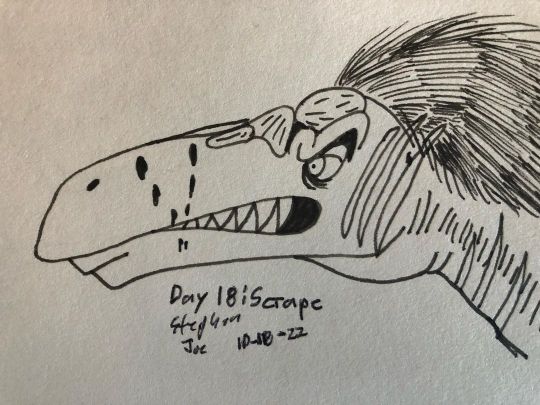
Day 18: Scrape A megaraptorid Murusraptor barrosaensis is having a crappy mode after he got battle scars and even bite marks as lots of scrapes. #inktober #inktober2022 #inktoberday18 #inktober2022day18 #artistoninstagram #myart #inkdrawing #murusraptor #murusraptorbarrosaensis #megaraptoridae #megaraptora #theropoda #dinosauria #dinosaur #paleoart #cartoon https://www.instagram.com/p/Cj3YKyev274/?igshid=NGJjMDIxMWI=
#inktober#inktober2022#inktoberday18#inktober2022day18#artistoninstagram#myart#inkdrawing#murusraptor#murusraptorbarrosaensis#megaraptoridae#megaraptora#theropoda#dinosauria#dinosaur#paleoart#cartoon
0 notes
Text
The study shows that in prehistoric Patagonia, these predators included dinosaurs from two groups: Megaraptoridae and Unenlagiinae.
Enantiornithines: were the most diverse and abundant birds millions of years ago; they resembled sparrows, but with beaks lined with teeth.
Ornithurae includes all modern birds living today; the ornithurines living in ancient Patagonia may have resembled a goose or duck, though the fossils are too fragmentary to tell for sure.
You’ve got your large theropod carnivores and smaller carnivores as well as these bird groups coexisting alongside other reptiles and small mammals.”
#paleontology#biology#dinosaurs#birds#science#scientific discovery#fossils#chile#cretaceous period#evolution#article#scientific paper
3 notes
·
View notes
Photo



Research: Malusaurus (Original Indominus)
Description: Description. Malusaurus is among the largest theropods—if not the very largest.
A member of the family Megaraptoridae, it possesses the same immense hand claws as other members of its family.
It is extremely different in other respects, though, having a proportionally short, robust skull.
0 notes
Photo
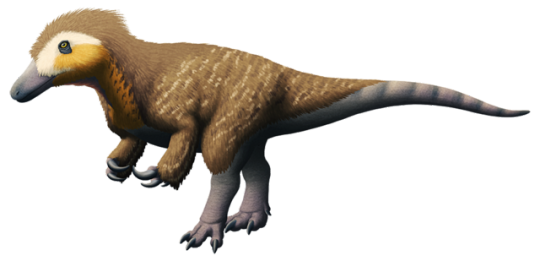
Australovenator wintonensis, a megaraptoran dinosaur from the Late Cretaceous of Queensland, Australia (~100-94 mya). It was a medium-sized member of the group, about 6m long (19′8″), and despite only being known from a partial skeleton it’s still one the best-known megaraptorans -- and also the most complete predatory dinosaur from Australia.
Megaraptorans were a group of fairly large theropod dinosaurs, currently known from Australia, South America, and Japan (and maybe Egypt). Their relationships to other theropod groups are rather uncertain, with different studies placing them as neovenatorids, tyrannosaurids, or most recently as an early branch of the coelurosaurs.
They had very lightly-built bodies, with bird-like bones full of weight-reducing air spaces, proportionally small heads with long slender snouts, and leg bones adapted for running. But their most distinctive feature was their hands, featuring massively enlarged claws on the first and second fingers, with the third finger being much smaller and somewhat vestigial-looking. While some other theropods like allosaurids and spinosaurids also had big hand claws, megaraptorans’ almost tyrannosaurid-like mostly-two-fingered arrangement is rather odd.
Their arms and fingers were much more flexible than those of most other non-avian dinosaurs, allowing them to reach out, grab onto prey with those claws, and then pull it in close to their bodies, restraining it in a sort of death-hug while their relatively weak jaws finished it off.
A distinctive injury to the second toe of Australovenator also suggests these dinosaurs may have been able to deliver powerful kicks like modern cassowaries.
#science illustration#paleontology#paleoart#palaeoblr#australovenator#megaraptoridae#megaraptora#coelurosaur#maybe#theropod#dinosaur#archosaur#art#speculative fluffiness#feather ALL the dinosaurs#yeah so basically these guys chase you down and hug you to death#(and you'd think jurassic world would be ALL OVER something called a 'megaraptor')#(but i guess they were too busy making weird chupacabrasaurs to notice ¯\_(ツ)_/¯ )
191 notes
·
View notes
Text
Maip macrothorax Aranciaga Rolando et al., 2022 (new genus and species)


(Coracoid [top, scale bar = 5 cm] and schematic skeletal [bottom] of Maip macrothorax, from Aranciaga Rolando et al., 2022)
Meaning of name: Maip = evil entity from Aónikenk mythology; macrothorax = big chest [in Latin]
Age: Late Cretaceous (Maastrichtian)
Where found: Chorrillo Formation, Santa Cruz, Argentina
How much is known: Partial skeleton of one individual, including several vertebrae, many belly ribs, and some limb bones.
Notes: Maip was a megaraptoran, a group of carnivorous theropods with large hand claws and relatively long arms. The relationships of megaraptorans to other theropods are debated. They were formerly thought to have been allosauroids, but recent studies have generally placed them as coelurosaurs, and sometimes even as a lineage of tyrannosauroids.
Estimated as having been almost 10 m long, Maip is largest megaraptoran discovered so far. It had a broad chest cavity that was probably over a meter wide. In addition, it is one of the youngest known megaraptorans in terms of geologic age. Given that other large-bodied megaraptorans are also known from the Late Cretaceous of South America, megaraptorans may have evolved into apex predator niches in South America following the extinction of the true allosauroids in the mid-Cretaceous, much like how tyrannosaurids did in the Northern Hemisphere.
Reference: Aranciaga Rolando, A.M., M.J. Motta, F.L. Agnolín, M. Manabe, T. Tsuihiji, and F.E. Novas. 2022. A large Megaraptoridae (Theropoda: Coelurosauria) from Upper Cretaceous (Maastrichtian) of Patagonia, Argentina. Scientific Reports 12: 6318. doi: 10.1038/s41598-022-09272-z
143 notes
·
View notes
Photo

Otro nombre que me fascina, y que también usa un idioma aborigen, es el de #Megaraptor namunhuaiquii, cuyo epíteto específico (que en mi última publicación les contaba que es el "apellido", la segunda parte de un nombre científico) significa "con lanza en el pie" en #mapugundun (la lengua hablada por el pueblo #mapuche). Esto se debe a que, inicialmente, el único resto fósil que se conocía de este #dinosaurio argentino era una garra solitaria de casi 40 centímetros (la cual pueden ver en la última foto en las manos de una muy joven e impresentable versión mía del 2014 en la colección del Museo Carmen Funes de Plaza Huincul, Neuquén), que se creía que pertenecía a un gigantezco raptor, ya que esos animales tenían una garra terrible en el pie con características morfológicas muy similares a la de Megaraptor. Posteriormente se encontró en Lago Barreales una mano completa que permitió a los paleontólogos saber que estaban ante una criatura muy distinta. La ubicación taxonómica de Megaraptor (y otras formas similares halladas posteriormente) ha ido variando, habiéndosele considerado como un dromaeosáurido, un espinosáurido, un megalosáurido, o un carcharodontosáurido, pero uno de los estudios más recientes ubica a esta familia, a la que se dio el nombre de Megaraptoridae, como miembros primitivos del grupo de los Tiranosauroideos, siendo posiblemente el único vínculo hasta ahora entre el famoso #tiranosaurio y las paleofaunas del Hemisferio Sur. ¡Saludos, y #SeanCreativos! 💭💡✏ 🌐https://smart.bio/martintalone #illustration #drawing #artefcnym #ink #inked #inkdrawing #paleontology #paleoart #fossil #fossilfriday #prehistoric #dinosaur #dinosaurs #tyrannosaurus #theropod #carnivore #predator #feathereddinosaur #argentinedinosaur #blackandwhite #animal #animals #jurassicpark #jurassicworld (en Martín Talone Art) https://www.instagram.com/p/CTAyGdUHeSo/?utm_medium=tumblr
#megaraptor#mapugundun#mapuche#dinosaurio#tiranosaurio#seancreativos#illustration#drawing#artefcnym#ink#inked#inkdrawing#paleontology#paleoart#fossil#fossilfriday#prehistoric#dinosaur#dinosaurs#tyrannosaurus#theropod#carnivore#predator#feathereddinosaur#argentinedinosaur#blackandwhite#animal#animals#jurassicpark#jurassicworld
37 notes
·
View notes
Text
Australovenator wintonensis

By Scott Reid
Etymology: Southern Hunter
First Described By: Hocknull et al., 2009
Classification: Dinosauromorpha, Dinosauriformes, Dracohors, Dinosauria, Saurischia, Eusaurischia, Theropoda, Neotheropoda, Averostra, Tetanurae, Orionides, Avetheropoda, Megaraptora, Megaraptoridae
Status: Extinct
Time and Place: About 95 million years ago, in the Cenomanian of the Late Cretaceous


Australovenator is known from the Phimopollenites Pannosus Pollen Zone of the Winton Formation in Queensland, Australia
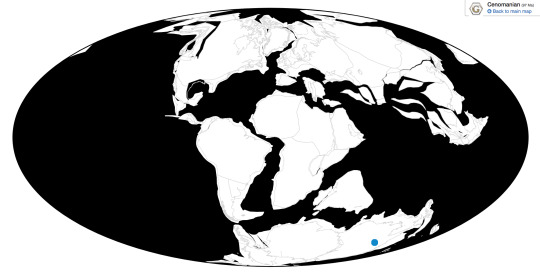
Physical Description: Australovenator was a Megaraptor, a group of fairly mysterious predatory dinosaurs that consistently confuse people since they were first discovered through today. The known parts of Australovenator are rather sparse - limbs and some parts of the torso, and a bit of the tip of the mouth. These elements show an animal with long legs, fairly long arms (for a theropod) with giant hand claws, and a slender jaw. The rest of our understanding of its size and shape is really based on its relatives. It would probably have been 6 meters long and 2 meters tall, weighing only 1,000 kilograms - making it a very lightweight, potentially fast predator. It had extremely flexible hands as well - more flexible than other theropods, almost able to pronate (ie, make “bunny hands”, which is not possible in other theropods). It also had extremely strong feet, built for kicking. Given that it was slender and small, it would have probably been covered in fluffy protofeathers all over its body.

By Ashley Patch
Diet: Australovenator would have been a major predator, able to eat a wide variety of small and medium sized animals in its environment - potentially even larger animals if it was able to work in groups.
Behavior: The behavior of Australovenator is not greatly known, given how mysterious Megaraptorans are as a general group. However, the extremely strong foot bones found with extensive signs of breakage indicates that Australovenator did use its feet to kick at prey, similar to modern emus. This would have greatly bruised and damaged the prey, potentially even breaking bones and causing internal bleeding and organ damage. The extremely flexible arms would have allowed it to use them to manipulate objects, grab at food, and easily claw at prey. In fact, the very large hand claws are notable for the Megaraptorans, since they were originally thought to be the giant foot claws of giant Dromaeosaurs. This ability to claw at and maim prey would have helped Australovenator extensively in taking down prey.
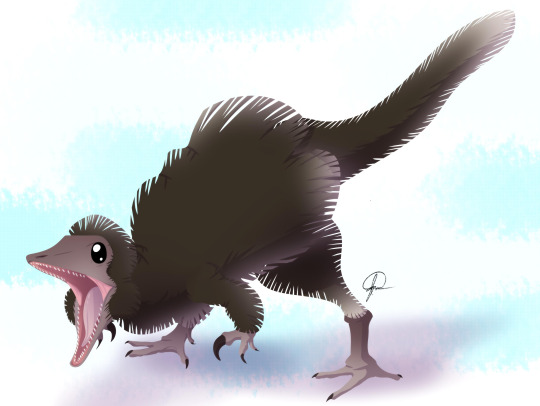
By José Carlos Cortés
Were Megaraptorans social? We aren’t sure. Australovenator was a powerful predator, clearly able to take down other animals in its environment without much help. It may have worked in small groups in order to get food larger than it, such as the sauropod Diamantinasaurus, since there weren't larger predators in its environment. However, there is no direct evidence to support that. Furthermore, in plenty of locations, Megaraptorans are very rare, indicating they wouldn’t have grouped up together much. Still, they usually aren’t the largest predators in a place, so the jury is out for Australovenator. As a dinosaur, it would have probably taken care of its young, though in what way is a question.
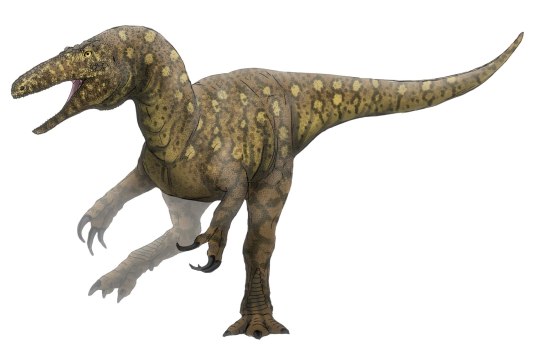
By PaleoEquii, CC BY-SA 4.0
Ecosystem: The Winton Environment was a river basin, next to the former inland Eromanga Sea. This was a highly forested ecosystem with extensive swamps, creeks, lakes, and estuaries leading back to the sea. The dense vegetation made it a hotbed for herbivores, which were all sources of prey for Australoveantor. In fact, Australovenator was found directly with Diamantinasaurus, a 15 to 16 meter long sauropod (indicating that Australovenator may have been scavenging, or worked in a group and was killed by a group member). Other herbivores included the titanosaurs Wintonotitan and Savannasaurus, and the Somphospondylian Austrosaurus. There were a variety of Ornithischians there, though none were named, they may have been Rhabdodonts or Elasmarians; and there was at least one Ankylosaur (probably a basal Ankylosaurid). In addition, there was the large pterosaur Ferrodraco, and the narrow-snouted Crocodylomorph Isisfordia.

By Ripley Cook
Other: Megaraptors like Australovenator are a taxonomical quagmire. They are either closely related to the Carnosaurs - animals like Allosaurus and Giganotosaurus - or to early Coelurosaurs such as the Tyrannosaurs. It’s possible they are Tyrannosaurs, full stop, but an early group of them. Honestly, the question is still up in the air - but they combine a lot of the characteristics of the earlier theropods with the more bird-like ones, which leads to this confusion. Regardless, Australovenator was a very late derived Megaraptor, nested deep within the group.
~ By Meig Dickson
Sources Under the Cut
Agnolin, F. L., M. D. Ezcurra, D. F. Pais and S. W. Salisbury. 2010. A reappraisal of the Cretaceous non-avian dinosaur faunas from Australia and New Zealand: evidence for their Gondwanan affinities. Journal of Systematic Palaeontology 8(2):257-300.
Apesteguía, Sebastián; Smith, Nathan D.; Valieri, Rubén Juárez; Makovicky, Peter J. (2016-07-13). "An Unusual New Theropod with a Didactyl Manus from the Upper Cretaceous of Patagonia, Argentina". PLOS ONE. 11 (7): e0157793.
Benson, R. B. J., M. T. Carrano, and S. L. Brusatte. 2010. A new clade of archaic large-bodied predatory dinosaurs (Theropoda: Allosauroidea) that survived to the latest Mesozoic. Naturwissenschaften 97:71-78.
Brougham, T., E. T. Smith, and P. R. Bell. 2019. New theropod (Tetanurae: Avetheropoda) material from the ‘mid’-Cretaceous Griman Greek Formation at Lightning Ridge, New South Wales, Australia. Royal Society Open Science 6:180826:1-18.
Carrano, M. T., R. B. J. Benson, and S. D. Sampson. 2012. The phylogeny of Tetanurae (Dinosauria: Theropoda). Journal of Systematic Palaeontology 10(2):211-300.
Csiki-Sava, Z., S. L. Brusatte, and S. Vasile. 2016. “Megalosaurus cf. superbus” from southeastern Romania: the oldest known Cretaceous carcharodontosaurid (Dinosauria: Theropoda) and its implications for earliest Cretaceous Europe-Gondwana connections. Cretaceous Research 60:221-238.
Hendrickx, C., and O. Mateus. 2014. Abelisauridae (Dinosauria: Theropoda) from the Late Jurassic of Portugal and dentition-based phylogeny as a contribution for the indentification of isolated theropod teeth. Zootaxa 3759(1):1-74.
Hocknull, S. A., M. A. White, T. R. Tischler, A. G. Cook, N. D. Calleja, T. Sloan, and D. A. Elliot. 2009. New mid-Cretaceous (latest Albian) dinosaurs from Winton, Queensland, Australia. PLoS ONE 4(7):e6190:1-51.
Holtz, Thomas R., Jr.; Molnar, Ralph E.; Currie, Philip J. (2004). Weishampel, David B.; Dodson, Peter; Halszka, Osmólska (eds.). The Dinosauria (2nd ed.). Berkeley: University of California Press. pp. 71–110.
Leahey, Lucy G.; Salisbury, Steven W. (June 2013). "First evidence of ankylosaurian dinosaurs (Ornithischia: Thyreophora) from the mid-Cretaceous (late Albian–Cenomanian) Winton Formation of Queensland, Australia". Alcheringa: An Australasian Journal of Palaeontology. 37 (2): 249–257.
Molnar, Ralph E.; Flannery, Timothy F.; Rich, Thomas H.V. (1981). "An allosaurid theropod dinosaur from the Early Cretaceous of Victoria, Australia". Alcheringa. 5 (2): 141–146.
Novas, F. E.; Agnolín, F. L.; Ezcurra, M. D.; Canale, J. I.; Porfiri, J. D. (2012). "Megaraptorans as members of an unexpected evolutionary radiation of tyrant-reptiles in Gondwana". Ameghiniana. 49 (Suppl): R33.
Pentland, Adele H.; Poropat, Stephen F.; Tischler, Travis R.; Sloan, Trish; Elliott, Robert A.; Elliott, Harry A.; Elliott, Judy A.; Elliott, David A. (December 2019). "Ferrodraco lentoni gen. et sp. nov., a new ornithocheirid pterosaur from the Winton Formation (Cenomanian–lower Turonian) of Queensland, Australia". Scientific Reports. 9 (1): 13454.
Porfiri, Juan D.; Novas, Fernando E.; Calvo, Jorge O.; Agnolín, Federico L.; Ezcurra, Martín D.; Cerda, Ignacio A. (2014). "Juvenile specimen of Megaraptor (Dinosauria, Theropoda) sheds light about tyrannosauroid radiation". Cretaceous Research. 51: 35–55.
Poropat, S.F.; Mannion, P.D.; Upchurch, P.; Hocknull, S.A.; Kear, B.P.; Kundrát, M.; Tischler, T.R.; Sloan, T.; Sinapius, G.H.K.; Elliott, J.A.; Elliott, D.A. (2016). "New Australian sauropods shed light on Cretaceous dinosaur palaeobiogeography". Scientific Reports. 6: 34467.
Salisbury, S. W., A. Romilio, M. C. Herne, R. T. Tucker, and J. P. Nair. 2016. The Dinosaurian Ichnofauna of the Lower Cretaceous (Valanginian–Barremian) Broome Sandstone of the Walmadany Area (James Price Point), Dampier Peninsula, Western Australia. Society of Vertebrate Paleontology Memoir 16. Journal of Vertebrate Paleontology 36(6, suppl.):1-152.
Tucker, Ryan T.; Roberts, Eric M.; Hu, Yi; Kemp, Anthony I.S.; Salisbury, Steven W. (September 2013). "Detrital zircon age constraints for the Winton Formation, Queensland: Contextualizing Australia's Late Cretaceous dinosaur faunas". Gondwana Research. 24 (2): 767–779.
White, M. A.; Cook, A. G.; Hocknull, S. A.; Sloan, T.; Sinapius, G. H. K.; Elliott, D. A. (2012). Dodson, Peter (ed.). "New Forearm Elements Discovered of Holotype Specimen Australovenator wintonensis from Winton, Queensland, Australia". PLoS ONE. 7 (6): e39364.
White, M. A.; Falkingham, P. L.; Cook, A. G.; Hocknull, S. A.; Elliott, D. A. (2013). "Morphological comparisons of metacarpal I for Australovenator wintonensis and Rapator ornitholestoides: Implications for their taxonomic relationships". Alcheringa: An Australasian Journal of Palaeontology. 37 (4): 435–441.
White, Matt A.; Benson, Roger B. J.; Tischler, Travis R.; Hocknull, Scott A.; Cook, Alex G.; Barnes, David G.; Poropat, Stephen F.; Wooldridge, Sarah J.; Sloan, Trish (2013-07-24). "New Australovenator Hind Limb Elements Pertaining to the Holotype Reveal the Most Complete Neovenatorid Leg". PLOS ONE. 8 (7): e68649.
White, M. A., P. R. Bell, A. G. Cook, D. G. Barnes, T. R. Tischler, B. J. Bassam, and D. A. Elliot. 2015. Forearm range of motion in Australovenator wintonensis (Theropoda, Megaraptoridae). PLoS ONE 10(9):e0137709:1-20.
White, Matt A.; Bell, Phil R.; Cook, Alex G.; Poropat, Stephen F.; Elliott, David A. (2015-12-15). "The dentary of Australovenator wintonensis(Theropoda, Megaraptoridae); implications for megaraptorid dentition". PeerJ. 3: e1512.
White, Matt A.; Cook, Alex G.; Klinkhamer, Ada J.; Elliott, David A. (2016-08-03). "The pes ofAustralovenator wintonensis(Theropoda: Megaraptoridae): analysis of the pedal range of motion and biological restoration". PeerJ. 4: e2312.
White, Matt A.; Cook, Alex G.; Rumbold, Steven J. (2017-06-06). "A methodology of theropod print replication utilising the pedal reconstruction of Australovenator and a simulated paleo-sediment". PeerJ. 5: e3427.
Zanno, L. E.; Makovicky, P. J. (2013). "Neovenatorid theropods are apex predators in the Late Cretaceous of North America". Nature Communications. 4: 2827.
#Australovenator wintonensis#Australovenator#Theropod#Megaraptor#Dinosaur#Factfile#Palaeoblr#Dinosaurs#Theropod Thursday#Cretaceous#Australia & Oceania#Carnivore#paleontology#prehistory#prehistoric life#biology#a dinosaur a day#a-dinosaur-a-day#dinosaur of the day#dinosaur-of-the-day#science#nature
328 notes
·
View notes
Link
20th JULY 2016
New member of Megaraptoridae was published in late July after bones were discovered in Sierra Barrosa Formation in Patagonia, Argentina during a 2001 excavation.
The article notes this specimen of Murusraptor to be “one of the most informative megaraptorids known, having preserved the posterior elements of the skull and several post cranial elements.” These elements may help scientists better understand the evolutionary significance of the group Megaraptoridae. As of now, the group is hypothesized to be either “derived allosaurid neovenatorids” or “tyrannosauroid coelurosaurs.”
--See PLoS ONE Article Below--
Coria RA, Currie PJ (2016) A New Megaraptoran Dinosaur (Dinosauria, Theropoda, Megaraptoridae) from the Late Cretaceous of Patagonia. PLoS ONE 11(7): e0157973. doi:10.1371/journal.pone.0157973
Full Text Link: http://journals.plos.org/plosone/article?id=10.1371/journal.pone.0157973
#scinews#new species#murusraptor barrosaensis#megaraptoridae#Pataogonia#Sierra Barrosa Formation#Upper Cretaceous#Theropoda#MCF-PVPH-411#PLoS ONE#paleontology#paleonews#dinosaur#news
0 notes
Text
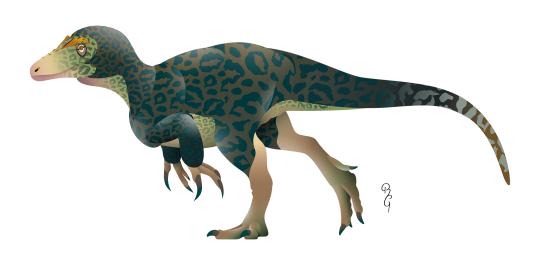
Orkoraptor burkei (2nd take, I corrected the neck posture and some other details)
Reference: Christopher Chavez (https://www.artstation.com/khriskath)
Vector illustration, 2023.
#paleoart#illustration#theropod#dinosaur#cretaceous#vector#argentina#megaraptoridae#megaraptora#orkoraptor
24 notes
·
View notes
Photo

Happy #DinosaurDay and here’s a new Megaraptorid dinosaur art to celebrate the same day of the month, Maip macrothorax. No NFT related post/account allowed. #paleoart #artistsoninstagram #myart #sketchbookapp #maip #megaraptora #megaraptoridae #theropoda #dinosauria #dinosaur #nationaldinosaurday https://www.instagram.com/p/CdmMOcwPQRi/?igshid=NGJjMDIxMWI=
#dinosaurday#paleoart#artistsoninstagram#myart#sketchbookapp#maip#megaraptora#megaraptoridae#theropoda#dinosauria#dinosaur#nationaldinosaurday
1 note
·
View note
Photo

another caracara-lookalike megaraptorid
128 notes
·
View notes
Photo

megaraptorid and pterosaurs around a cretaceous patagonian lake
32 notes
·
View notes
Photo

I’m been a lot of time to doodled, and then inked and painted on my iPad from last 2 weeks as the end of the month. Anyways, I did my latest paleoart of Megaraptor, but with southwestern theme paleoart since I was as an Navajo artist. #megaraptor #megaraptoridae #megaraptora #neotheropoda #avetheropoda #ornithoscelida #paleoart #navajo #nativeart #southwestern #nativeculture #autodesksketchbook #sketchbookapp https://www.instagram.com/p/B12tMcNlQWd/?igshid=12l07c1b0upvz
#megaraptor#megaraptoridae#megaraptora#neotheropoda#avetheropoda#ornithoscelida#paleoart#navajo#nativeart#southwestern#nativeculture#autodesksketchbook#sketchbookapp
2 notes
·
View notes
Text

Day 4: Dinosaur
A Megaraptoran Murusraptor barrosaensis.
Based on the skull but fully restructure by Jaime headden.
#my art#dinosaur#animals#dinosaurs#paleoart#dinosauria#Megaraptoridae#Megaraptora#avetheropoda#theropoda#procreate5x#procreate
0 notes